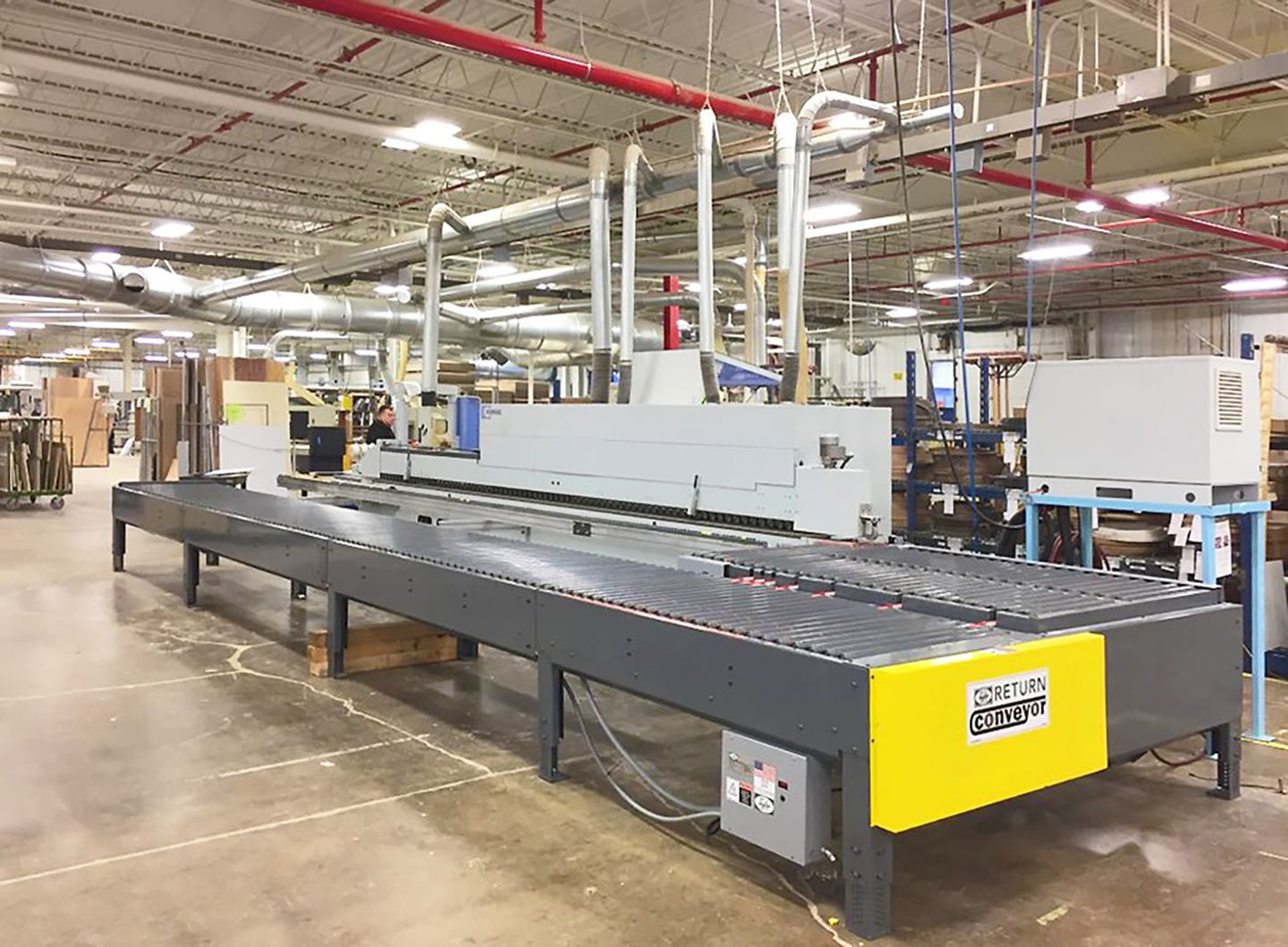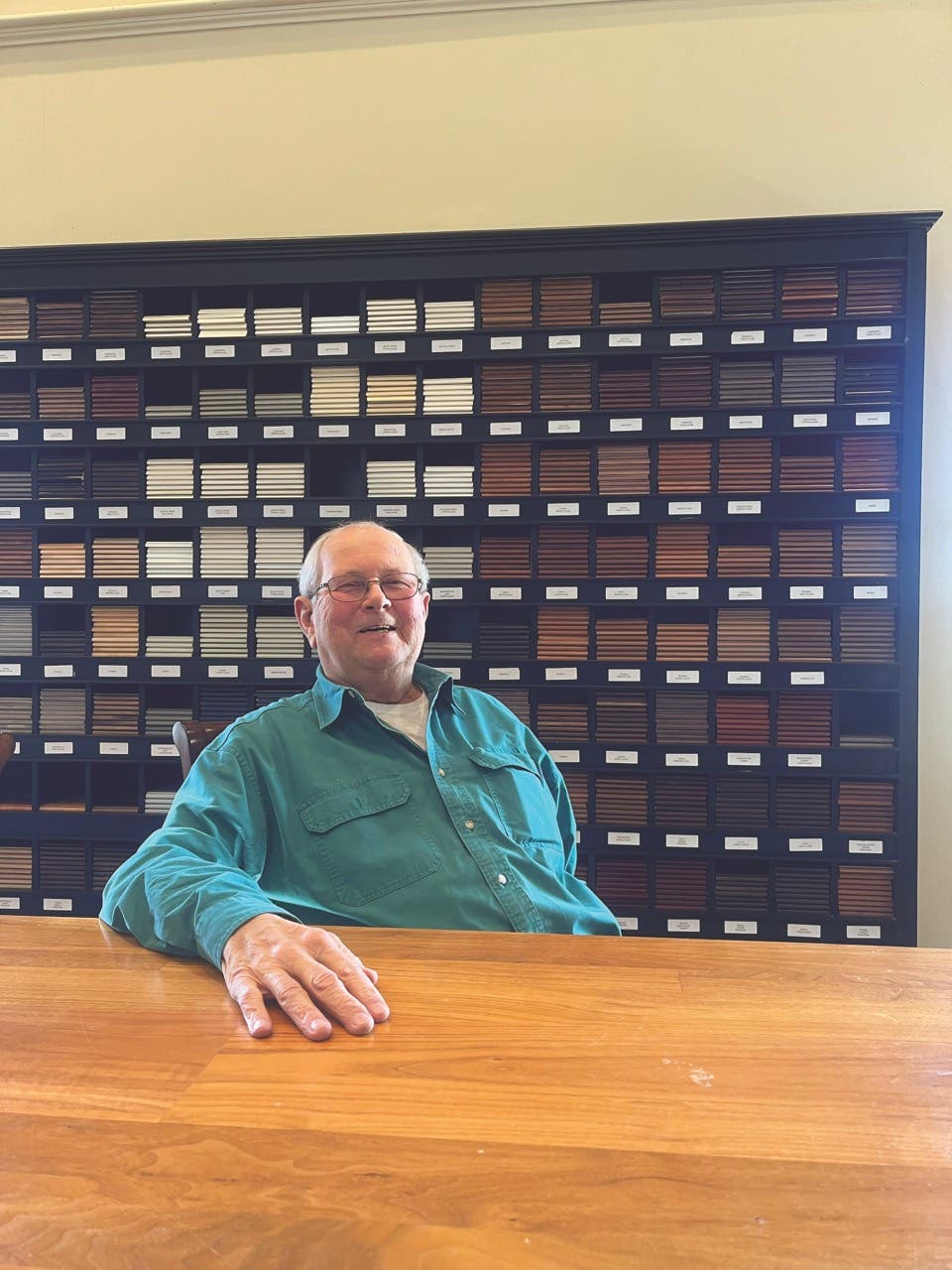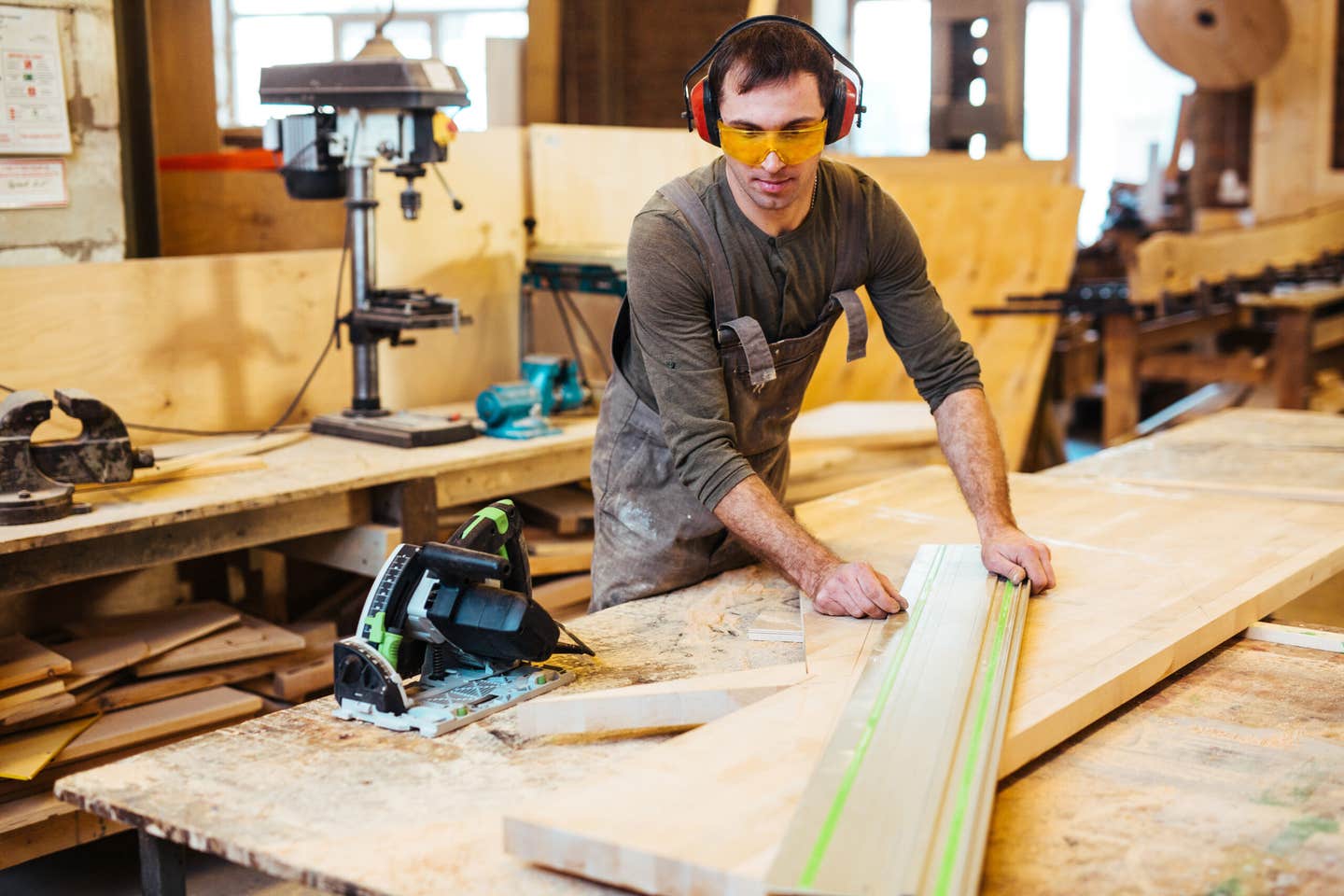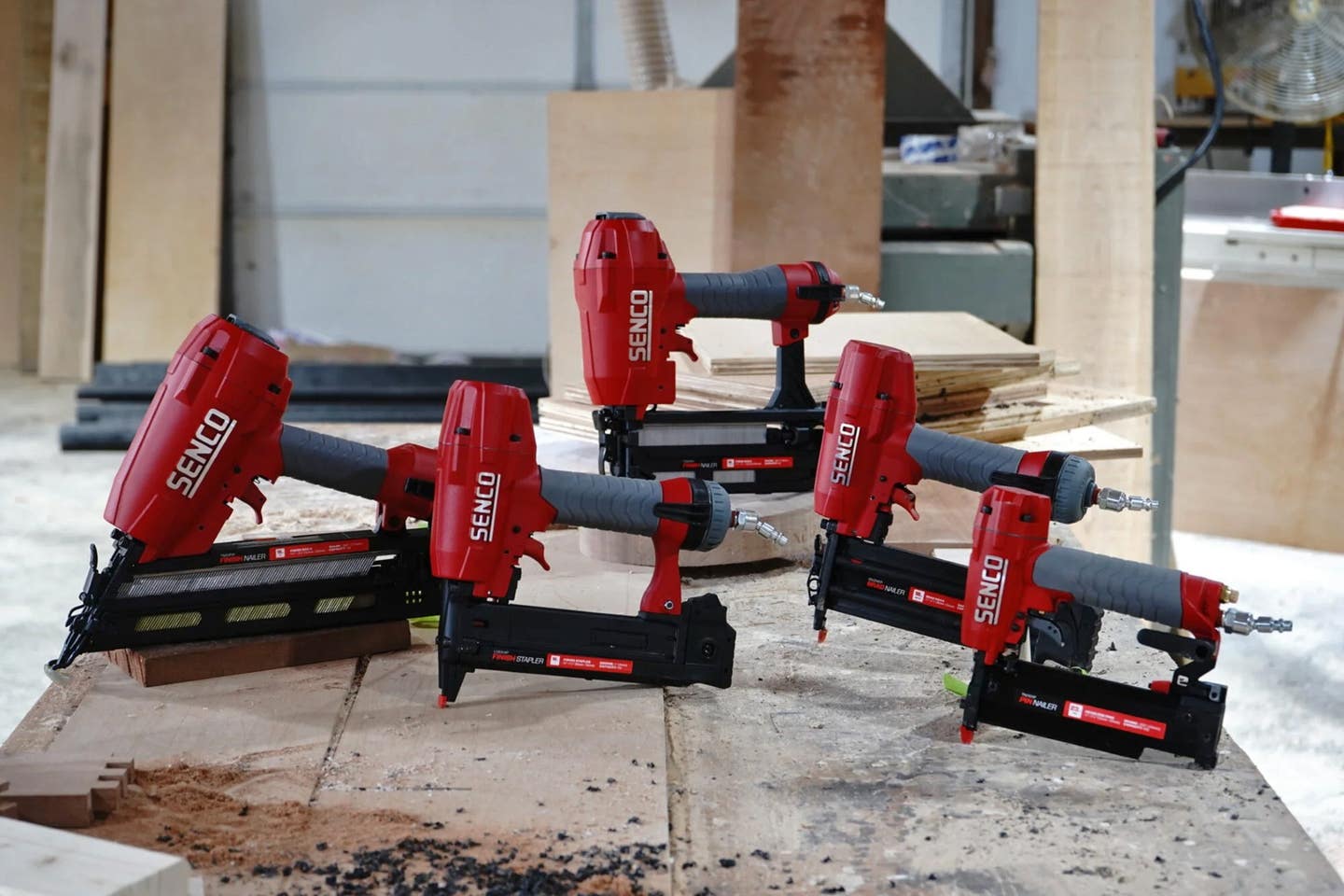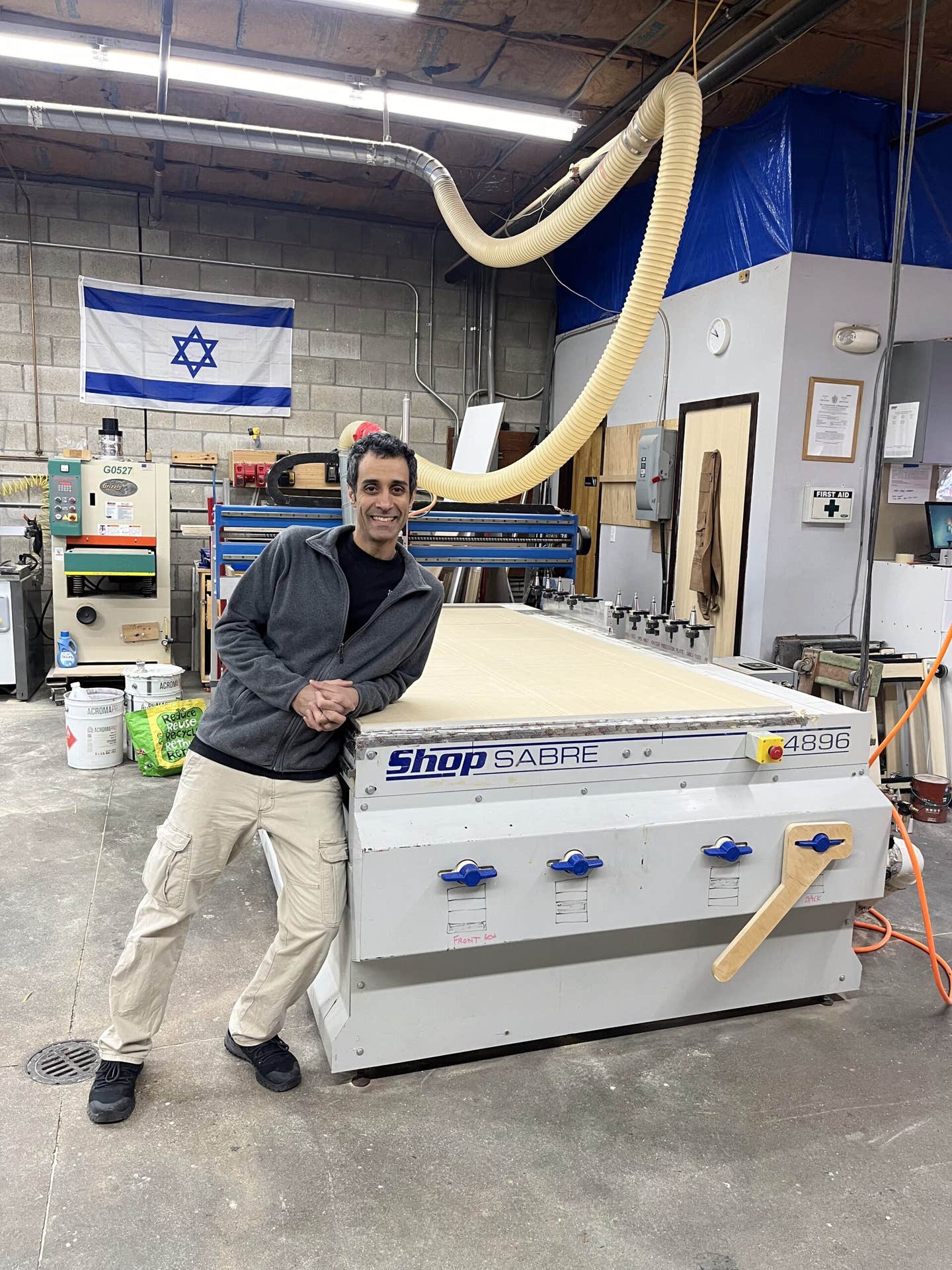Adding More Direction
If you’re building furniture or complex parts, a 5-axis CNC is an option worth exploring.
A standard 3-axis CNC router can machine the top face or the edges of flat cabinet parts, using a cutter that descends from above and then moves sideways into the part. That’s all that the majority of casework projects require, but many machines have the potential to do a lot more. The actions in 3-axis milling are the standard X (left and right), Y (forward and backward) and Z (up and down) movements. While moving in these three directions, the spindle always maintains its vertical orientation. That is, the business end of the spindle/router with the cutter/tool/bit is always pointing down toward the table.
Larger woodshops and artists who create unique furniture pieces take these basics to another level in a process that involves 5-axis machining. For them, the tool moves in the X, Y and Z linear, or straight-line axes, and then it also rotates on two more planes called the A and B axes (more details in a minute). This lets the cutter approach the work from virtually any direction, which adds true 3D machining capabilities. So, 5-axis machining refers to the number of directions or axes (which is the plural of axis) in which a cutting tool can work. It gives the woodworker the ability to simultaneously cut or shape on five sides or faces of a piece of material.
We’ve skipped over something obvious here, which is 4-axis milling. That’s because most shops tend to jump from three to five directions, simply because it makes more sense. Here’s why: Imagine a cube that is sitting on your CNC bed. On a 3-axis machine, you can mill the top and the sides in a limited fashion. Those limits are imposed by the fact that the bit can go in and out at 90 degrees, but it can’t work at, say 37 degrees to create a custom chamfer around the top edge (unless you add an aggregate head – more on that, too, in a minute). It also can’t address the bottom of the cube with a straight bit, because it can’t reach under an object even if that object were to be suspended off the table. It can only approach the sides at 90 degrees with an edge-cutting bit, so it can’t really reach up under a form.
But if you add a fourth axis that allows the cube (rather than the cutter) to rotate – and we’re not talking spinning here yet, but just simply turn upside-down – you can now mill the bottom of the cube. Imagine that you’re standing in front of the machine and watching, so the part would rotate 180 degrees either toward or away from you on an invisible axis that runs from left to right. That’s the fourth axis. This is how CNCs can be adapted to essentially become lathes and make columns, posts and spindles. In those cases, of course, the fourth axis doesn’t just rotate, it spins at speed. Think of the fourth or A axis as a rotatable X axis. That is, your spindle can move along the X axis, and then the A axis lets you move around the X axis.
Now, let’s visit the fifth axis. This, the B axis, is a rotational movement around the Y axis (note than some machines treat Y and Z as interchangeable if the table moves). Imagine that the cube can also rotate sideways. Its right face moves up as its left face moves down or the other way around, but the center stays where it is. This new axis allows the cube to spin like a propeller on an airplane, or a baton being twirled in a marching band. Or it would allow a part to be rotated slowly just a few degrees and stop, so that a specific angle could be milled on a tapered edge, or perhaps the top of a newel post could be reduced to a ball shape.
Reduced is an important word here. Cutters, saws, mills and router bits are all subtractive tools. They work much in the way a sculptor does, by removing (subtracting) excess material to reveal a part. CNCs can also be used for additive technology, which today usually means 3D printing where thin layers of plastic are applied (added) to a form. Five-axis machines can greatly enhance the speed and accuracy, and the creative possibilities for both subtractive and additive processes.
Just to confuse the issue, a sixth axis (C) is also possible by spinning around the Z axis, but this is rarely used in woodworking. However, a limited version of that can often be achieved if the table has the ability to tilt.
Simultaneous synchronization
A true 5-axis machine allows movement in all five axes, and all at the same time. That means that instead of completing one operation and then moving the part or changing the cutter or loading new CAM instructions, the machine smoothly and easily transitions from one process to the next. Because the zero point (where the tool initially established its relationship to the table and the surrounding space) never changes, the transitions can be extremely smooth. It also means that very intricate operations such as finely detailed relief carving can take place and reach around corners or follow curves. A 5-axis machine can turn or move a part even as it is being milled, and that combination of simultaneous actions where both cutter and part are mobile can open up a whole new world of possibilities. The tool can reach five faces of a part without ever stopping.
More than half of the parts produced by CNCs would benefit somehow from being milled on a 5-axis machine rather than a 3-axis router. And a woodshop that upgrades to five axes can also upgrade its catalog. Not only can the new machine do more intricate work that can be offered for sale, it can also do it faster and more economically. But the decision requires a lot of thought because the initial investment can be quite high, and then there’s a lot of retraining to do if the shop wants to maximize the new machine’s potential.
A less expensive option is 3+2 milling, which has the standard 3-axis capabilities and the option to manually move the part on the fourth or fifth axis and then lock it in place so that it can be milled. Here, the part is stationary after being moved into position and secured, so it doesn’t rotate during the cutting operation. But the cutter still has significant access, so the 3+2 solution works well for many shops.
Another way to achieve many of the effects of 5-axis milling, and do so on a budget, is to use an aggregate head. This is an attachment that goes on the spindle and allows the cutter to change direction. It’s like having a hinge on a router bit. The spindle can still only move in the three basic directions (X, Y and Z), but the plunge bit or saw blade or perhaps a profiled bit in its jaws can ‘swing’ so that it can reach a little bit under the work, or approach from a different angle. It might, for example, be set up with a saw blade that trims the bottom edge of a board at 15 or 20 degrees. For that, the board would need to be locked in place with a spacer below it so the tool can get underneath. Aggregate heads can be used to complete tasks such as creating complex moldings, or carving panels in relief, or perhaps working with various brands of knockdown RTA (ready to assemble) hardware where they create custom pockets and mortises even on angled edges.
Why would I need 5 axes?
Honestly, most cabinet shops don’t. But if you’re building furniture or complex parts, this is an option worth exploring. A true 5-axis CNC has a number of sometimes subtle advantages that, when looked at together, make this a better choice for many shops.
For a start, there is speed. A woodworker is able to program a complex routine with tool changes and then stand back and watch a three-dimensional part being manufactured with no stoppages required to change set-ups or the work holding (that is, adjust the clamps or vacuum). Imagine that you’re making electric guitar bodies or necks, and you need to mill the front and back of each body to shape so they feel smooth and comfortable, and then mill or drill recesses for various electronic components, cut micro dadoes for fret wire, shape the complex headstock, drill for the machine heads, locate the bridge, mill for the volume and tone knobs and make mortises or pilot holes for items such as the strap buttons, the pickup and guard, or the input jack. Now, think of doing all of those set-ups individually on a 3-axis CNC and having to move the part each time and then make a host of adjustments because nothing is square and simple to locate on this curved, organic shape. A 5-axis CNC allows milling on every surface and in all directions except in the limited area where the part is being held or clamped. Plus, the flexibility built into the head means that the tool can move in more than one direction at the same time. That means that complex profiles can be milled without the need to spend valuable shop time building custom fixtures to hold parts at the correct angles.
That ability to work on a part without re-fixturing brings up the next advantage of 5-axis machines — a higher degree of accuracy. Every time a part is moved and re-clamped, even with great care, it will never occupy exactly the same space it did before. Woodworkers are very familiar with the benefits of repeatability, and also with the frustrations associated with it. By mounting a part just once and having the machine work from a single reference (zero point), the shop avoids problems such as dust accumulation on a jig, or maybe slight movement in a fixture. Every time we touch and move parts, we change the dynamics no matter how much care we take to duplicate a previous action. On a 3-axis machine, the operator hopes that several parts are being realigned perfectly after the workpiece is moved. On a 5-axis machine, the part is locked in place just once. All that handling also opens up the process to the possibility of human error. An operator can get left and right or up and down confused, or can forget to tighten a clamp or check a vacuum.
Five-axis machines also cut faster and more efficiently because the bit can address the work at ninety degrees even when the surface of the part is shaped or contoured. That’s called a tangential approach, where the cutter can plunge and cut with the most power and the least possibility of vibration because it’s not working at an awkward angle. (The word ‘tangential’ is perhaps more familiar when used to describe the use of CNCs that hold knives for cutting softer materials such as leather and plastic.) Because the router bit or mill is tangential to the surface being cut, the cycle time is shorter and this saves a little time, too. Plus, the shaft on the tool can be shorter because of the reach afforded by a 5-axis spindle, and that also contributes to eliminating any mild vibration. The result is usually a slightly smoother cut, which saves time in sanding and finishing operations.
There are several ways that 5-axis machines can be configured. Swivel-rotate style machines create their rotary axes by rotating the spindle around the table. That is, the machine rotates the B-axis around the Y-axis and the C-axis around the Z-axis. This style is best suited to machining heavy parts because the table remains stationary. Trunnion machines have a moving table, and this can work better for machining larger parts. It also provides more access for undercuts because there is more that ninety degrees of rotation in at least one of the axes. A trunnion table moves the A-axis around the X-axis and the C-axis around the Z-axis.
Decisions, decisions…
Ultimately the choice about whether to upgrade from three to five axes will depend on the shop’s work volume. Many other considerations come into play such as parts quality and personnel, but the real litmus test here is whether the volume of work can justify the investment. If it doesn’t, then those other factors just don’t matter. A woodshop owner may have to decide that a true 5-axis machine is beyond the budget and begin to explore some options with 3+2 milling or adding an aggregate head to an existing 3-axis machine. That said, this may be a great time to also think about adding a vacuum table or at least vacuum fixturing, as the pods generally take up a lot less room than shop-built mechanical fixtures or jigs. An aggregate head can reach into so many places that the old set-up may get in the way and limit the head’s potential.
If the upgrade is financially viable, then there are a few factors to keep in mind. One of these involves our limited ability to envision what will happen before we hit the start button. Simulation software allows the operator to preview exactly where the spindle and tool will be at all times, and thereby avoid collisions with machine parts. There is nothing as heart-wrenching as getting everything set up perfectly and then watching the bit try to eat the gantry support, or the spindle crash into the tool-changer.
Five-axis software has taken some quantum leaps over the past few years, especially in the areas of collision control and post-processing. This latter is software that converts toolpaths that were created in a CAM system into NC programs that can be read by a machine’s controller. What it does is takes universal data and makes it usable in a specific machine. It does that in part by taking into consideration the specific machine’s kinematics, which describe the physical way in which the axes on a machine move. This is especially important when it comes to the two rotary axes on a 5-axis machine and their ability to handle transitions, feed and speed, chip rates and so on.
Tooling is a new issue, too, when one upgrades. There are high-speed tools made specifically for 5-axis operations that can open up new possibilities. Because the machine can maintain a constant chip load due to the tangential cutting position, the cycle time and the life of the tool are both extended. Less sharpening or replacement means less downtime, which in turn means lower costs and better profitability. Not only is the machine not being stopped and started several times, but personnel on the shop floor are also not being taken away from other tasks to provide that frequent support for the machine.
Holding the work is going to be a whole new concept, too, and will take some getting used to. There are going to be far fewer set-ups, but you’ll need to re-think some basic physics. The spindle can now do some very athletic things that are going to eliminate most of the jigs and fixtures that were built over the years for that old 3-axis machine.
This article was originally published in the September 2020 issue.



